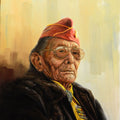Santa Ynez Chumash Museum and Cultural Center Opens
By Chadd Scott on
A dream more than 20 years in the making becomes reality when the Santa Ynez Band of Chumash Indians opens its new museum and cultural center to the public on Thursday, May 15, 2025. Costing approximately $32 million, the 14,000-square-foot facility located on the corner of Highway 246 and Edison Street in Santa Ynez – land owned by the tribe adjacent to its reservation – showcases historically significant cultural items, including baskets, musical instruments, hunting tools, ceremonial items, and regalia, all highlighting the richness and diversity of Chumash culture. At the museum entrance, visitors will be greeted by a monumental sculpture, Keeping our Culture Alive, commissioned by the tribe’s Elders Council and crafted by renowned artist George Rivera (Pueblo of Pojoaque).
The museum’s unique architecture, designed by award-winning Jones & Jones Architects, designers of the Smithsonian National Museum of the American Indian in Washington, D.C., is anchored by large dome structures paying homage to the Chumash people’s traditional dwellings, the tule ‘ap.

Santa Ynez Chumash Museum and Cultural Center exterior view. Photo by Patrick W. Price. 1
The building achieved LEED® Silver certification from the U.S. Green Building Council for its environmentally sound design. LEED, or Leadership in Energy and Environmental Design, is the most widely used green building rating system in the world, and its certification is proof that a business is going above and beyond to ensure the building is constructed and operated to the highest level of sustainability.
Outside, a 3.5-acre cultural park features exhibits and more than 11,000 drought-resistant California native plants across a water-efficient landscape, including nearly 100 species used by the Chumash. Water conservation is particularly important in the Santa Ynez Valley’s distinctive arid climate. Water is reused throughout the museum site for toilet flushing and irrigation, reducing the need for potable water by 100 percent.
Guests can also explore a work-in-progress Chumash ‘ap home outdoors, and visit the Ancestors’ Grove, where oak trees and commemorative family stones pay tribute to tribal ancestors.
Another highlight of the museum gardens is the Tomol House. Tomols are the tribe’s traditional redwood plank canoes. This particular tomol is named Muptamai, and throughout the year is paddled along the Pacific coast and occasionally at Aquitsum (Lake Cachuma). The boat helps paddlers prepare for the Santa Barbara Channel crossing and supports intergenerational Chumash community gatherings. Each year, when Muptamai makes her crossing, Chumash people from various bands unite in ceremony to celebrate and honor ancestors and seafaring traditions.
Remarkably, the museum will also be displaying the last female condor living in the wild in 1986 before all 27 surviving individuals were captured for safe keeping and captive breeding. The tribe acquired the taxidermy animal from the California Department of Fish and Wildlife.
The condor is a sacred animal to the Chumash who perform a condor dance during ceremony.

Santa Ynez Chumash Museum and Cultural Center exterior view. Photo by Patrick W. Price. 2
Maria Solares
One of the Santa Ynez Museum and Cultural Center’s two domes bears the name Maria Solares Discovery Center. Solares was a revered ancestor and keeper of Chumash language, stories, and teachings.
“She worked really hard back in 1914 to 1919, working with an ethnographer and a linguist to save all of these stories,” Kathleen Marshall (Samala Chumash), Museum Board Chairwoman for the Santa Ynez Chumash Museum and Cultural Center, said. Marshall considers Solares “the matriarch of our tribe.”
The Chumash people from the Santa Ynez Valley refer to themselves as Samala Chumash. Samala is also the name of their native language. Museum text features Samala throughout. The Samala word for condor is “almiyi’.”
While this knowledge and history has long existed within the tribe, the new museum and cultural center makes it all vastly more accessible.
“The culture and language have always been there, but we have a lot of our tribal people living out of state who can’t attend our programs that we offer to our tribe,” Marshall said. “(The new museum) gives our people the opportunity to come in and learn and to heal and to be around the artifacts of our ancestors at any given time. They don't have to set an appointment. They don't have to wait for a program. They don't have to wait for one of our culture bearers. This is all right here for them. This really, truly, in my heart, is here for our community.”

Santa Ynez Chumash Museum and Cultural Center exterior view. Photo by Patrick W. Price. 3
Looking Forward
The Santa Ynez Band of Chumash Indians is located in Santa Barbara County. Historically, the tribe’s territory encompassed over 7,000 square miles of the most beautiful land anyone has ever seen. It covered 200 miles of coastline from Malibu to Paso Robles, unimaginably valuable real estate to use a capitalist, 20th century context. The tribe’s homeland stretched from the Channel Islands to the western edge of the San Joaquin Valley, south to Los Angeles County, north to Kern County.
Its reservation was established and officially recognized by the federal government in 1901. Today, the Santa Ynez Band of Chumash Indians remains the only federally recognized Chumash tribe in the nation. The tribe is a self-governing sovereign nation and follows laws set forth in its tribal constitution.
“This (museum and cultural center is a) lens for our people and for the outside community to learn about our people from the beginning up till now,” Marshall said. “We are resilient. We are strong. Yes, you can come in and learn about our history and all of the tragedies that we've been through, but in the end, we're resilient. We're strong. We made it through all of this.”
The tribe is looking ahead. A bright future made brighter by the new Santa Ynez Museum and Cultural Center.
“I've been preaching this to everyone, this next generation coming up is going to have all their culture and everything that our grandmother (Solares) left for us right there at the tip of their fingers,” Marshall said. “It's only going to make us stronger. It's only going to make our tribe stronger. It's going to make our community stronger. Our youth are going to walk right into it, knowing that they have all of this knowledge right there ready for them.”
The facility will be open from 10 a.m. to 5 p.m., Thursday through Sunday, with tickets available for purchase at www.sychumashmuseum.org. Adult general admission for non-tribal members is $15.00.



